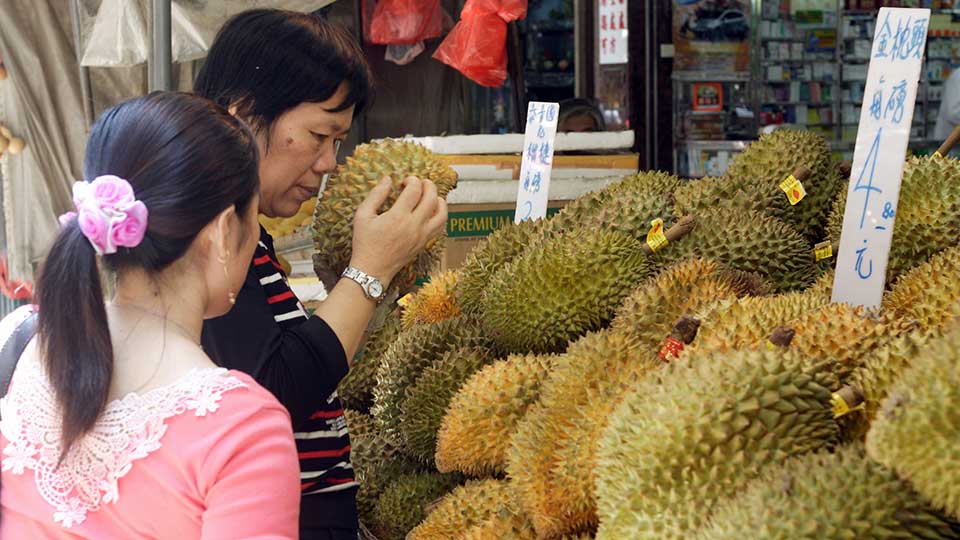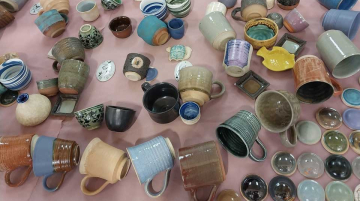
Analysts estimated that about three decades ago, Thailand sent to China its first batch of fresh durians – the pungent, spiky fruit native to Southeast Asia. Since then, Thailand’s Monthong durian’s creamy and custard-like texture has dominated the Chinese palate.
“Thai durian growers have all become rich because of China,” Thai economic analyst Aat Pisanwanich told CGSP. “There are no other markets apart from China for Thailand.”
Thailand was the first ever allowed to sell durians to China, but as time went on, high demands led China to source the fruits from others, challenging Thailand’s position as the sole exporter of durian to the country.
Thailand is still at the top, but farmers are beginning to worry that it might someday lose the spot to other Southeast Asian countries like Vietnam, Malaysia, or Indonesia.
Panusak Saipanich, a Thai durian grower, said that any hiccup in shipment from Thailand could now spark irreversible damage to the industry. This year, Thailand is able to send a record of nine hundred containers, each containing about 18 tonnes of whole durians, per day to China. The Thai agriculture ministry aims to export no less than 700,000 tonnes of fresh durians to China this year, to be worth about $3 billion.
“Durians from Thailand’s east, our major harvest location, are ripe around February to May, while Vietnam’s durians are usually ready between June and September,” Saipanich explained.
Today, over 85% of the durians on the market in China and Hong Kong are still from Thailand, according to an estimation by Pisanwanich. China imported a record 221,000 tonnes of durians in April 2023 alone, almost as much as the annual import in 2017 at 224,000 tonnes.

Since 2018, Malaysia has sent batches of frozen whole durians to China. Its Musang King cultivar is considered gourmet and with its limited amount each year, its market price is the highest there. In July 2022, Vietnam became the second country allowed to export fresh durian to China after four years of negotiations, making the most of its tropical climate in the south and its border with China in the north. Its first shipment was in September that year.
Vietnam’s durian export revenue has exponentially risen in a matter of months since. In May, the export value of durian reached a record $332 million, more than 10 times higher than the previous month. In the first five months this year, Vietnam’s durian export value rose to half a billion dollars, more than 18 times higher than the same period last year, with China importing around $477 million worth of durians.
In April, the Philippines shipped its first batch of fresh durians to China following President Ferdinand Marcos Jr’s state visit in January in what a Philippine official dubbed “durian diplomacy”. This happened despite the South China Sea dispute that continued to engulf both countries.
This year, China’s first harvest of its locally grown durian hit the shelves. The fruit was grown in Hainan where the climate is comparable to Southeast Asia. The first harvest was lower than expected, but enough to inform durian growers elsewhere that the market would only become more competitive in the future.
In the first five months this year, no fewer than 477,000 tonnes of fresh durians were already shipped to China. This year’s expectation is lower than last year’s export at over 827,000 tonnes, of which 96% were sent to China, due to a nationwide drought that affected agricultural produce.
Thai durian farmer Busaba Nakpipat said she became worried at first after learning that China had grown its own durian, but due to “China’s weather and winds, it will not be that easy,” she said.
What worried her more was the fact that Thailand’s costs of fertilizers, logistics, and labor were higher than Vietnam’s. In her view, this could affect Thailand’s competitiveness in the Chinese market.
However, farming academic Sakda Srinives said Vietnam had no reason to rely on pricing competitiveness alone due to the high demand in China.
“Monthong durians from Thailand are priced at $130 per 18kg box, and those from Vietnam are close behind at $110 a box, a good price for a country that has exported fresh to China only last year,” Srinives said. “Not to mention that it only takes two days for durians from Vietnam to reach China, compared to seven days of transportation from Thailand.”
Srinives added that many Thai and Chinese durian middlemen now set up their businesses in the Vietnamese city of Dak Lak, the center of its durian farming, to benefit from Vietnam’s geological proximity to China.
He predicted that Cambodia, where a number of Chinese businessmen have invested in durian plantations, would be allowed to export durian to China next even though the produce here is still low.
Thailand and Vietnam’s batches of durian enter China at the checkpoints at Guangxi before a majority of export shipment is headed to markets in major cities like Shanghai where middle-class Chinese scoop them up, said Saipanich.
Pisanwanich, the analyst, estimated Indonesia could be next in line to be permitted to export durian to China as the country is in need of Chinese investment funds in its many sectors, most of all in durian plantation.
In a recent development, President Joko “Jokowi” Widodo met with Chinese counterpart Xi Jinping in July in Chengdu and extended an invitation for China to invest in Indonesia’s durian plantations to take advantage of the billion-dollar Chinese durian market.
Pisanwanich said Thailand’s durian quality control needs to be the priority to secure the China market in the long term. Currently, durians that are grown in the neighboring countries are smuggled into Thailand before being shipped off to China as a Thai product to get better pricing in the mainland, making quality oversight almost impossible. However, he didn’t see Thailand being replaced any time soon.
“Thailand could still dominate China’s durian market for the next five years, but after that, the risks will be high,” said Pisanwanich.
Jitsiree Thongnoi is a journalist based in Bangkok, Thailand. She focuses on politics, social equity and China’s role in Southeast Asia.






